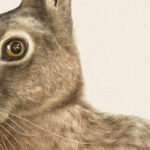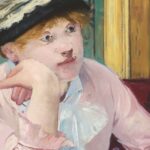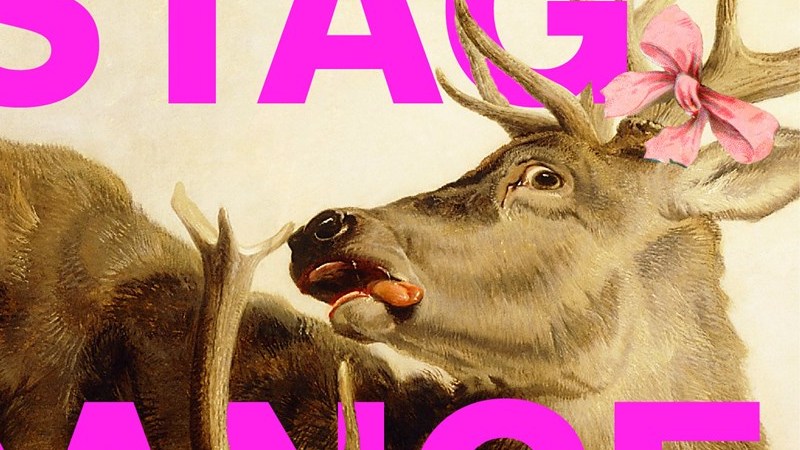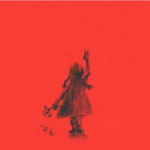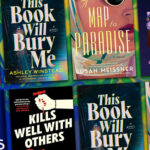Minorities Are the Majority
Salena Godden on Shade, Belonging, and Growing Up Mixed-Race in Britain
Shade: Comparative darkness and coolness caused by shelter from direct sunlight.
The darker part of a picture.
A position of relative inferiority or obscurity.
To publicly criticize or express contempt for someone, to act in a casual or disrespectful manner towards someone, throwing shade, acting kinda shady.
Sometimes I think I am about the same shade as Beyoncé. But it is hard to tell because it depends how much light they give her. Some days I think I’m about the same shade as Rihanna, but that’s also difficult to say as she switches shade too. Your shade is not skin deep. Your shade is not just about your heart and soul; your religion and spirituality, your elders and your history, your connection to a country, to geography and to a time and place. Your shade is an industry, your shade is a token, shade is a passport, shade is a cage, and shade is a status.
You tick: Other.
I am in Bangkok. The billboards on the streets and sides of buses are dominated by adverts for a skin-lightening product called “Snail White.” Glossy pictures of westernized Thai girls with cheerleader smiles and faces of palest ivory. In the markets and restaurants I observe Thai residents with bleached skin and powder-white faces; in the streets some wear gloves protecting their brown hands and thick white tights to conceal brown legs in 40-degree heat. I never noticed this so much before. I think I missed a memo, but the internet informs me that skin bleaching has been trending for years—from India to Africa, the Caribbean, all over the world, skin bleaching is big business and the shade of your skin is your freedom or your prison. The color of the outside of you dictates existence and acceptance. Your shade is the symbol of your wealth, your beauty, your worth, and your success.
Here we are then, this is Britain, where white people dye themselves as brown as tea stains. The desire to tan continues to thrive, people toasting themselves to sunbed death. The first sign of a UK heatwave and our beaches and parks are awash with salmon pink bodies and barbecued lobster faces. Celebrities on the covers of gossip magazines are crab orange; reality television stars are streaky antique teak.
Wherever you live, wherever you are from, it seems it is all about shade. Universally we are divided, and whatever shade you are born it is not right or good enough. We are in a giant brainwash, we are being organized by color and tone, the natural shade of your skin must be improved, altered, and filtered. Your skin is a living organ. Your skin is the casing for your sausage-meat soul. And the armor for your muscles, bones and flesh. Skin is the protective layer of the interior of you with the exterior world, but it is always wrong. You are too white or too black. Too light is bad? Too dark is bad? I get confused. I am in the middle here. Hang on a minute, what shade am I to you?
My mother is the same shade as Oprah or Maya. Some summers I have seen my big brother almost as brown as Idris but closer to Obama in the winter. Bob Marley was mixed, Jamaican and Celtic, same as me, his shade looks pale in some photos, sometimes much darker. You see, it all depends on the filter and the time of year, it all depends on the light, it all depends on the shade. It depends on what point people are trying to make, to advertise things, to sell you things, to make money. That is the point, to get the shade right, to make shade the issue. To give shade, to put someone in the shade, to put someone in their place, to let someone know they are less, more or less, because of their shade. Advertising companies, big corporations, banks and politicians need to maintain this, to control the division of people through racism and shade, throwing shade of difference and indifference, good immigrant and bad immigrant, refugee and benefit scrounger. This keeps us in our place, humans bickering, focusing on their differences, distracted, and at each other’s throats, competing and separating—
Divide and rule.
I now imagine a giant separating people like he is recycling glass at the bottle bank: brown skin glass there, yellow skin glass here, white skin glass over there. But most people aren’t simply one or the other, either black or white. What about me? Where are you putting the two-tone people?
I wish the giant would pick the glass people up and hold us all up to the light. Then he’d see that together and united as a people we are a beautiful picture, a multicolored mosaic, a glorious stained-glass window. But the giant just scratches his head and continues flinging people in separate buckets. Referencing his color chart guide for shades of human—Paddy Field Brown is Poverty. Greasy Chip White is Skint. Black Panther Beret Black is Super Bowl Uproar. Shot Teenager is Chalk On Bloody Concrete. Crack White is Baby Momma’s Bitch. Geisha is Pink Cherry Blossom. Ping Pong is Ladyboy White. LA Orange is Porn Slut. Tangerine Queen is Essex Teak. Cardboard Grey is Benefit Scrounger. Rat Tail Beige is Food Bank. Cheerleader Pink is Under-Age Pop Tart. Fox Hunt is Tory. War Crime is Blood Diamond Red. Arab Oil is Gold Dust. Drowned Brown is Refugee. Immigrant Brown is Better Media Coverage. The giant shrugs. He throws some people in the other bucket and some in the sea to die. His supervisor reminds him it is vital to tell the difference between Immigrant Brown and Refugee Brown. Let’s be diligent about that. Let’s make sure we pay attention.
News just in . . . What is the shade?
Boko Harem Black. Entire village. Over 80 people burnt to death in their homes.
No. Not newsworthy. Not important. Bring Back Our Girls.
No. Not Today. Black Lives Matter. No. Not Today.
Say Her Name. Not newsworthy.
Terrorist bomb, blood on European soil. Headline. Front page.
The indifference is clear. The difference is as clear as oil and gold. We must know the divide. Know your shade. Whose shade are you on? Whose side are you on? None of us can ever un-see the violent images of immigrant children washed up on beaches and plastered over the front page of newspapers. Or the ashy broken babies trapped beneath rubble and bomb debris. How safe are the children? How safe is it for immigrant children in transit? All over the world, wherever they end up, whatever the shade of their skin, refugee brown or immigrant brown, who is protecting the kids from the predators, traffickers, from rape and murder?
Do you mind me asking you a question: where do you come from?
You tick: Other.
I pull up a chair and wait to be processed. I wait here while you print off your labels, and consider me for your boxes marked black as in black-black or black as in brown-black, or brown as in half-black or brown as in half-caste. But hang on a minute. Surely if I am from two colors, two races, I am two shades, and therefore not half-caste, not half anything, but whole, I am double-caste. But half sounds shadier. Half is best because half means less. You lose. You are half a person. We don’t want you getting all empowered, now do we.
Half-caste. Half-breed. Mulatto.
Ah, now there’s a shady word we don’t hear too often, but a word used liberally throughout my teenage years. And most recently a word revived in the US press in a piece about Halle Berry, a shitty article that debated what we should call her mixed children. How rude and how old money is the word mulatto? That word is pure shade with its connotations and meanings. The word mulatto comes from the Spanish and Portuguese—it is derived from mula, meaning mule, the hybrid offspring of a horse and a donkey. But I am not a mule, and I am not made from two species.
My parents are Jamaican and Irish-English. My passport is British and I have lived in England all my life. My fire and spirit is pure Maroon rebel. They didn’t teach us about the significance of the Maroons at school, but growing up Jamaican it was always Black History Month back home. My grandparents wanted me to know where we all came from, how the Maroons rebelled to rise and fight against slavery. Through storytelling in the kitchen my grandparents gave me history lessons, a map and a time machine.
Welcome aboard my Good Ship. Let us sail to the colorful island of mixed identity. You are free to use your own rules and savvy because they haven’t invented a filter for our shade yet. You are a pirate and you’re itinerant. You eat from the cooking pot of mixed culture and bathe in the cool shade of being mixed-race. You disembark and hesitate, your pen hovers over your boarding pass.
You tick: Other.
“I don’t think of you as black, not really black-black . . . ”
Not black enough. But not white enough either. You are on the playground and you keep your mouth shut as your classmates argue. “She’s not black, she’s brown, but she’s not black-black, not like really black . . . ” Your plaits are too frizzy and messed up for the Strawberry Shortcake girls; you are too loud and bright and boisterous for them. Maybe they are too girly and pink for you, anyway. They smell of Parma violets and baby powder. You smell of cocoa butter. You stay in the shade they provide, you find your own light inside, you find strength and you are taught that you are outside.
You tick: Other.
There’s a rising fashion for golden-brown skin and curly hair. Mothers at the school gates coo and nudge each other.
“She’s so lucky, she has a sun tan all year around, mine comes out of a bottle!” They laugh as someone’s mum pats your head, her hand bounces a bit.
“I wish I had your curly hair, can I touch it?”
You tick: Other.
After school, spotty white teenagers in Tacchini tracksuits writhe and jolt, body-popping and breakdancing, competing at caterpillars and windmills on a piece of lino in the street to hip-hop on their ghetto blaster—they call it a Ghetto Blaster. Breakdance has exploded and suddenly everyone wants to be a rapper, everyone wants to be other. These same white boys who might have teased you and called you golliwog a year or two ago, now suddenly call you “sister” in a fake Yardie accent.
You tick: Other.
You go to live in the city. You and your friends have been studying drama, and you go for castings, auditions for extra work and modeling jobs. Most of the time you are turned away for being too exotic. Casting agents look at you with a puzzled expression and shrug and say:
“We don’t book your look . . . we don’t really specialize in exotic girls.”
Someone suggests you join an agency for exotic people and scribbles down an address. You are penniless and desperate for work so you go. When you get there, there are film stills of aliens, photographs of dwarfs on the walls. Ah, penny drops! Of course, brown people belong in the circus, with the aliens and the dwarves, not in beauty campaigns, but with the elephant man, with the outsiders and the other others. You give them your CV and hope to get offered extra work, non-speaking parts: the prostitute, drug dealer, or dead girl. You get a part as an extra in a prison riot scene; it pays the rent that month.
You tick: Other.
My mother is a black immigrant. She was born in Port Antonio, Jamaica. She lived in the Robinson family home on Colonels Ridge, Bulls Head Mountain. There are more shades of green there, and more shades of sky, than anywhere else in the world; it is so beautiful. My mother’s tropical childhood days were idyllic. She was barefoot and carefree, picking mango fresh from the tree and swimming in clear, warm turquoise oceans. My mother had no idea what England was, or who King George was. She knew nothing of the war; there was no shortage of sugar, cocoa or coffee. Jamaica was the center of the world. Her father was in the RAF and posted to Dover, and so just before my mother’s seventh birthday, December 1951, my grandmother and my mother left that warm paradise and stepped onto a banana boat to set sail for England to join my grandfather.
The passage took several weeks. My mum vaguely remembers the ocean crossing, my grandmother making friends with the other passengers. Most of all she remembers how they switched boats off the coast of Ireland, and she was terrified as she was winched across from the shipping boat onto a passenger ship, as though she were just like a box of bananas. My mother had been born in the colorful paint box of Barrington Watson and suddenly she found herself in the coal grey industrial frame of a Lowry. England was one long bitter winter’s day; my seven-year-old mother shivered at the docks in a short-sleeved cotton dress. Her feet, so used to being bare, were now shoved into these hard shoes she hated. And the flags were all at half mast, King George had just died. February, 1952.
She remembers all of this as a traumatic time.
Back in Jamaica they had told her how wonderful England was, that the streets were paved with gold. But she recalls arriving to find an atmosphere of lost hope, of people’s dreams being dashed, a collective depression and disappointment. Newcomers to England found it hard and cold: cold with animosity, cold in the shade cast on them.
She has an early memory of a white child, just opposite, across the street, pointing at her:
“Mummy, Mummy, look at the blackie.” The mother yanks her child’s hand, “Now, now, dear, don’t stare.”
At her new English school, my mum remembers the teachers, how they always put the immigrant children to work together in groups. The brown faces, teeth chattering, shivering on the field, stuck in pairs for sports. Keeping the outsiders outside, keeping the others, other. The newcomers were united as outsiders and lived in a community. One of my grandmother’s first friends when she arrived in England was a neighbor, a Polish woman who showed her some practical things, like the way to the shops and how to keep the house warm and keep out the draughts. That Polish immigrant neighbor knitted my mum her first wool cardigan, a kindness my mother remembers even now.
Meanwhile, my father was white; his mother was an Irish immigrant. We don’t know much about this side of my story because he was adopted, and his birth mother disappeared without trace. My paternal grandmother was an Irish 15-year-old scullery maid, working below stairs in a big house. When she fell pregnant with my dad, the case went to Juvenile Court; she said she’d been taken advantage of by the lord of the manor, the big boss of the house had got her in the family way. It is all very Downton Abbey in my mind, but not much of a happy ending. This 15-year-old girl disappeared as the ink dried on the adoption papers, and we now know nothing of my Irish roots. And the fact remains that my paternal grandfather must have been a wealthy and reprehensible brute as he kept his name well out of it and off the record. It was his word against hers in the 1940s, that of a poor 15-year-old Irish immigrant maid against a white man of means and wealth, she didn’t stand a chance did she? And nor do immigrant teenagers in this century. Wherever they end up, wash up, whatever the shade, refugee or immigrant, torn away from their parents and homes, I repeat my question: who is protecting the kids from traffickers, from rape and murder?
My parents fell in love and married in the swinging 1960s. They were part of a circle of open-minded, cosmopolitan groovers, musicians and bohemians. My father was a brilliant jazz musician, and my mother was a go-go dancer. That was how they met, my father down in the pit, looking up at the legs. Every time I tell people my father was a jazz musician they picture him as a black man and my mother as the white; funny, isn’t it?
But away from their mix of bohemian jazz friends and swinging 60s hippy circle, the prejudice showed its ugly self, primarily as an ignorant curiosity about their sexual relationship. People sniggered and said the most filthy things, the racist connotation being that my mum was untameable and wild from the jungle. Men would nudge each other dirtily and make crass jokes that my father was a lucky man, the common joke going along the lines of:
” . . . I bet he has his work cut out in the bedroom.”
The fetishization of the sexuality of black people comes from centuries of dirty dark shade. It starts with sleazy old jokes that black men have huge cocks, or that black women are hyper-sexual, and it festers to become something toxic and sinister. This continues now, mostly unquestioned, with the sexual objectification of women, rounded fat bottoms and full lips all across the media industry. But once the canned laughter dies down or the fashion shoot is done and dusted, and you stop and take a cold hard look at the root history of these jokes and stereotypes, it all comes from a shade so bleak and so ignorant, that it has a sub-human subtext to it—brown people for sale in a human pet shop window.
When my mother had her babies she remembers that the immigrants, the black and Asian mothers, were all put together at one end of one ward. She recalls some nurses were unkind, a bit snotty, making sure they knew they were in the shade, that they were being cast aside, treated differently and were somehow inferior. And afterwards, in the street, as a new mum were proudly pushing her pram, people would stop to look, peering in, curious to see her offspring. Staring down at me, a chubby pale blonde bundle in the pram.
“Are you sure that’s your baby?” they’d ask rudely, without a flicker of thought for the hurt that comment might cause.
James Robertson, my great-great-great grandfather, is known in my family as the Colonel. By the time he died he was in fact a General, General James Robertson. A Scottish man, who we recently discovered is buried at Edinburgh University. The Robertson mausoleum is in Greyfriars Cemetery. His oil painting hangs in the National Army Museum; it is a portrait of a white man in a white wig, red jacket, medals and epaulettes. I believe that he was rewarded for his excellence in capturing Maroons with hunting dogs. I feel uncomfortable when I see his portrait, and visiting his grave I can visualize it all… Gnarling dogs snapping in the moonlight, Maroon warriors waiting in ambush, camouflaged in the rain forest undergrowth, a human fox hunt, the masts of distant ships, hidden treasure, piracy and subterfuge. We weren’t taught about the Maroons at school. They were renowned for inventive guerrilla warfare and fierce courage, living by the Maroon mantra that called for them to fear no death:
“To never bow head or knee, to hear only their own voice, to stand in the shadow of none and to be masters of their own destiny.” Robertson was given land in Jamaica, and this whole area of Clarendon is still called Colonel’s Ridge to this day. Robertson married a Maroon—she was in fact a Zulu princess—and through miseducation and misdirection his name changed from Robertson to Robinson. He didn’t correct anyone’s spelling because he faired better in Jamaica. He abandoned his wife and children in Scotland for a life living as a wealthy plantation owner in the blue mountains of Jamaica.
So now what shade are we? I am a child of immigrants, the first being this Scots man, Robertson or Robinson, an immigrant from Scotland to Jamaica. We are all connected. We live in the shade and shadow of secrets and lies, this shared dirty history of colonialism, rape, land theft, and slavery. Slavery was abolished, at a cost, with promises of land and wealth and freedom. Jamaica may have gained independence from Britain in 1962 but today we still chase those broken promises and fight for truth, justice, and reparations.
Now, these are just a handful of the things that I hardly ever talk about; these are memories that give me uneasy feelings of doubt, and things that remind me that to some I am nothing but a shade. And these are also the moments that inspire me to keep writing and to keep fighting to speak and to be heard and to be read. This shade I wear, this outer skin, this isn’t a lovely natural perm or a lucky all-year tan, this is my past, present, and future; this shade is my identity. As a kid I was the curly-haired brown girl with bright green eyes. I was an alien, and I stood out in the school group photographs. You can spot us right away, me and my brother; the two grinning brown faces in a sea of white. But you pass any playground now and there are millions of us. I occasionally work in schools, teaching poetry workshops and giving talks, and I’m delighted to walk into a classroom to see a sea of countless colors and mixes, beautiful mixed-up, double-dipped, curly-tops. Most of us are mixed something or other; the world is majorly populated with minorities.
We tick: Other.
There is a dream, a grand idealism, that mixed-race people are the hope for change, the peacekeepers, we are the people with an other understanding, with an invested interest in everyone being treated equally as we have a foot and a loyalty in many camps, with all shades. We are like love bombs planted in the minefield of black and white. It is as if our parents intended to make us, with courage, and on purpose, as vessels of empathy, bridges for the cultural divide and diplomats for diversity and equality.
As you grow older, as a mixed-race person, you become a chameleon. You are born with natural camouflage. When you travel everyone assumes you are some version of Latino or Spanish. In the first minutes of meeting you, people have to figure out what shade you are, and this is your superpower: it buys you valuable time. People will show their hand and ask, “Where do you come from?”
And if you reply, “I just jumped on the tube at Tottenham Court Road,” they’ll tut and shake their head.
“No,” they say, “where do you come from, as in . . . ” Pause. “. . . come from, come from?”
You earn time to chameleon, to camouflage, to make your shade darker or lighter. To morph into what is required or expected. Whatever it takes to survive, whatever it takes to be heard, whatever it takes to get the job. Whatever armor you must wear that day. It’s all positive discrimination. Right? No. Wrong. Very. Wrong.
You hesitate, your pen hovers over your boarding pass. You tick: Other.
For me, being another shade has not been a guarantee of being published by a BAME [Black, Asian, Minority Ethnic] publisher, to be included in black literary magazines, or that my work will be supported by the black press or BAME media. I haven’t relied on tokenism or any positive discrimination. I have, however, always felt that I have to work ten times as hard, and that my voice is mine, but that it is different. I keep my head down, I keep on keeping on, and I show up to work to write every day. I like to believe that I am booked for festivals and events and published for my merit and talent, and not for the tokenism of my shade or even my gender. I have hope and feel strongly that diversity and equality are improving in the UK. It’s a long and slow simmer, but I have seen improvement since I started out in 1994. I perform regularly, and share the stage with a comparatively even mix of boys and girls, black, mixed, and white. But we still have such a long way to go; the headline acts are still mostly white and male. I continue to survive and thrive due to my own tenacity and the generous support of others, people who identify as being other: the warriors and outcasts, rebels and renegades, the revolutionaries, the circus, the outsiders and underdogs, the working-class heroes, the punks and the poets and the LGBTQ+ community too. We have learned to belong in the un-belonging. Spirited and colorful souls, of all shades.
We tick: Other.
Some people seem to think that BAME writers, colored folk, are all in some clique, saluting our savior Zadie Smith sipping coconut water and sharing jerk chicken sauce recipes. That is not true. And neither is it true that BAME writers write with BAME readerships in mind. It also isn’t true that all our books solely contain stories for each other, about each other, and about our roots, like travel diaries, tales that will only interest other homesick BAME people. I call bullshit on all of that. The shade of your skin is not the whole content of you and your work. The shade of your skin should not be the measure of your worth. The shade of your skin is not your only audience nor should it be a limitation.
The universal job of being a writer is to write: to write with empathy, to be brave and honest, to find joy conveying a journey and in sharing your passion. Your ink is replenished by your life experiences, by taking off the mask and using your limitless imagination, by stepping out of the shade and into the light. As a woman may write in the voice of a man, I don’t see why a writer cannot imagine the voice of another shade and culture; that is what imagination is all about. Whatever shade you are, as a writer, you have just one task each day, one battle, and that is you against the blank page. Every writer should have just that in mind; just that one fight is more than enough to contend with, each and every morning.
You and your pen against the empty page.
Britain is an island surrounded by salt seawater and inhabited by people of every shade. I do not think of people as flocks of sheep but more as shoals of fish, swimming to find food and heat and migrating to survive. We could protect each other better if we swam together in unison; we could protect each other from great white sharks dominating everything. We could, but we are like fish, as fickle as fish.
I finish writing this piece at Arvon. I’m working at the writing residency, The Hurst in rural Shropshire. This week I’m tutoring an all-BAME and all-female group of writers, poets and playwrights. I just discovered that this is the first time that Arvon has programmed an all-BAME and all-women course since Arvon began in 1968. I feel honored to be chosen to be here this week. I observe the women sharing stories, the challenges of being women writers, the struggles to be funded and to publish work. I am stunned by the openness of the dialogue, moreover the shocking lack of confidence which comes from having to lower your expectations, shrinking your dream because of a stream of constant rejection and the lack of opportunities here in the UK, especially if you are a BAME woman and aged over 30. Above all, this week is evidence to me of things improving, new platforms being provided and good people helping to change things. Things are slowly getting better; I can see an improvement since the 1990s, but it is just taking way too long.
All I can do is keep on keeping on, keep sailing my Good Ship. Human color is the color I’m truly interested in, the color of your humanity. May the size of your heart and the depth of your soul be your currency. Welcome aboard my Good Ship. Let us sail to the colorful island of mixed identity. You can eat from the cooking pot of mixed culture and bathe in the cool shade of being mixed-race. There is no need for a passport. There are no borders. We are all citizens of the world. Whatever shade you are, bring your light, bring your color, bring your music and your books, your stories and your histories, and climb aboard. United as a people, we are a million majestic colors. We are building a cathedral of otherness, brick by brick and book by book. Raise your glass of rum, let’s toast to the minorities who are the majority. There is no stopping time, nor the blurring of lines or the blending of shades. With a spirit of hope I leave you now. I drink to our sameness and to our unique differences. This is the 21st century and we share this, we live here, in the future. It is a beautiful morning, it is first light on the time of being other, so get out from that shade and feel the warmth of being outside.
You tick: Other.
From The Good Immigrant, ed. Nikesh Shukla. Used with permission of Unbound Books. Copyright © 2017 by Salena Godden.




